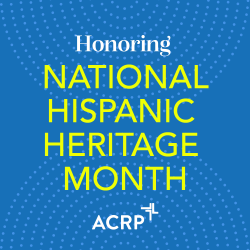In recognition of National Hispanic Heritage Month and the importance of clear communications between study teams and participants in clinical trials, no matter what their native languages may be, ACRP reached out to Emi Pell, Head of Sales and Marketing (Global) at Conversis, and Cassandra Andrade, Director of Strategic Accounts – Trial Interactive at TransPerfect and Brand Ambassador for Latinos in Clinical Research, to discuss careers and challenges related to translating study documents for patients.
Q: Can you tell us a little bit about how you got into the translations/language services business?
 Pell: Before I got into life sciences translation, I worked on the client side. I used to work in brand management and led an account for a major female sanitary product. The biggest barrier for the consumer was understanding how to use the product, so verbalizing and disseminating that information was a huge part of the job. Also, while not technically classified as a medical product, we had a lot of the same requirements in terms of labeling, Instructions for Use, etc. We would spend so much time creating the English content—months, most of the time, and sometimes years. And then, for our international audience (which was significant), we would hand this precious content off to a translation company with the assumption that any linguist working on the project would not only be able to understand the technical material and terms well enough to translate them, but also ensure the content was going to resonate in all of our target markets. Frankly, that just wasn’t the case—the effort put into the original content wasn’t communicated effectively, and the individuals in those target markets lost out as a result. That’s when I started to realize the importance of subject-specific expertise and the significance of “localization” rather than direct translation.
Pell: Before I got into life sciences translation, I worked on the client side. I used to work in brand management and led an account for a major female sanitary product. The biggest barrier for the consumer was understanding how to use the product, so verbalizing and disseminating that information was a huge part of the job. Also, while not technically classified as a medical product, we had a lot of the same requirements in terms of labeling, Instructions for Use, etc. We would spend so much time creating the English content—months, most of the time, and sometimes years. And then, for our international audience (which was significant), we would hand this precious content off to a translation company with the assumption that any linguist working on the project would not only be able to understand the technical material and terms well enough to translate them, but also ensure the content was going to resonate in all of our target markets. Frankly, that just wasn’t the case—the effort put into the original content wasn’t communicated effectively, and the individuals in those target markets lost out as a result. That’s when I started to realize the importance of subject-specific expertise and the significance of “localization” rather than direct translation.
Now, working in the language services business with the distinct mission to serve our life sciences clients, it’s vital that messaging is accurate, culturally relevant, and resonates. It’s been so rewarding having been part of a journey—particularly over the last few years—where patient communication has truly been prioritized, and I’ll never miss an opportunity to stress how important this continues to be.
 Andrade: My background is in public affairs, where I worked on historic U.S. and international initiatives aimed at shifting policies for global companies and U.S. citizens both in the public and private sectors. On a personal level, I was born and raised in the U.S. in a bilingual household, so the ability for me to communicate in two languages has been with me since birth. My first experience working in the life sciences industry was helping a vitally important academic institution translate its consent forms and recruitment materials from English into Spanish, Haitian Creole, and Portuguese for the U.S. Hispanic, Haitian, and Brazilian communities in South Florida. This is where I learned first-hand about some of the many challenges clinical researchers, especially at the site level, faced with patient recruitment and retention.
Andrade: My background is in public affairs, where I worked on historic U.S. and international initiatives aimed at shifting policies for global companies and U.S. citizens both in the public and private sectors. On a personal level, I was born and raised in the U.S. in a bilingual household, so the ability for me to communicate in two languages has been with me since birth. My first experience working in the life sciences industry was helping a vitally important academic institution translate its consent forms and recruitment materials from English into Spanish, Haitian Creole, and Portuguese for the U.S. Hispanic, Haitian, and Brazilian communities in South Florida. This is where I learned first-hand about some of the many challenges clinical researchers, especially at the site level, faced with patient recruitment and retention.
Q: What kind of training, if any, has been most useful to you (or those who work for you) when it comes to dealing with complicated medical documents—and especially with clinical trial-related documents/content?
Pell: Real life has been a hell of a teacher in the last few years, Working during COVID-19, we saw (and worked on) all the phases of a clinical trial in rapid succession. We also experienced in a very real way how significant timings and deadlines can be in terms of submissions, etc. It was literal life or death we were dealing with, in real time and in large populations. Clearly, it was a horrible time in many very important ways, but it was an exceptional environment to learn in, and fast. I have to say that the COVID-19 period was the first time my friends and family finally understood what it is I do for a living.
Andrade: After seeing the challenges experienced by study teams in need of translated versions of key essential documents (i.e., informed consent forms [ICFs]) to get patients from ethnic minority groups to participate in their trials, it was evident that communicating to non-English patients was often an afterthought and not necessarily built into the clinical trial design. It was essential for us to support these teams during those dire pandemic times. But we also help clients better understand the risks and impacts of expediting translations and/or sharing what we have learned about the benefits of having the content localized, because I have seen firsthand more than a handful of times when an often “nice to have“ translation or interpretation request becomes a necessity that directly impacts a patient’s life. That is part of the training. It is our responsibility to share these stories and remind our colleagues in the industry that localizing content can help non-English speaking patients when they need it the most!
Q: Thinking specifically of work on translations for Hispanic/Latino audiences, what facets of cultural awareness/sensitivity are at the top of your mind when it comes to documents/content explaining clinical trials, such as recruitment brochures or informed consents?
Pell: Our experience of working with and for Latinx audiences is that trust is a major factor; one that needs to remain top of mind throughout any work being completed for them. Our understanding is that there is a distinct lack of trust amongst the Latinx audience when it comes to U.S. authorities, so this trust needs to be built carefully and deliberately. Primarily, where this intersects with the work we do is in ensuring the Latinx audience can see themselves in the materials being produced. It needs to be made clear that our clients understand and care about them as a community. One of the best ways to do this—beyond translation itself—is to ensure that any imagery used reflects and appeals to the Latinx population. It’s also important in doing this to bear in mind the diversity within this population—one size does not fit all any more than it would if targeting a white American audience. Another facet of this is—somewhat obviously—ensuring that translations are clear, accurate, and precise, so people can be confident they know what they are consenting to and there are no surprises undermining trust along the way.
Andrade: The Hispanic community is diverse. Yes, we are all Hispanics/Latinos, but it’s very important to understand that even within the Latino community there are various cultures and communities. It is not a one-size-fits-all approach. Depending on where you travel in the U.S., you might hear people describe or even pronounce a word in English a different way. For example: When at a restaurant in the U.S., some English speakers, depending on where they are from, might order a “soda,“ “coke,“ or “pop“—and that really depends on what city or state you are from or visiting. The same is true for Latinos/Hispanics in the U.S. Localizing content to communicate to Latinos in California, where the community is primarily of Mexican descent, is different than doing it for the Puerto Rican community in New York/New Jersey or for Cuban-Americans and Colombians in South Florida, for example. Moreover, when we look at minority communities, the economic, education, and financial literacy attainments are diverse. Therefore, in addition to the language, we should consider other aspects such as the community‘s reading level proficiency, etc.
Q: Do you get much feedback from your clients that helps you revise documents/content as time goes by?
Pell: While we regularly get feedback from our clients, this is usually more along the preferential language lines; rarely in the cultural appropriateness sphere. That is very much the arena of our linguists, so that kind of advice tends to travel the other way. The main thing we ourselves have learned in the last few years is the importance of in-country linguists. For U.S. Latinx audiences, rather than working with linguists based in Central or South America, it’s essential to work with linguists speaking those languages but living in the U.S., since cultural context is key. In the same way that something that works well for a white American audience may not work so well for a Latinx audience, the same can be said for a Spanish-speaking audience in the U.S. vs. South or Central America.
Andrade: It’s vital to remember that a literal translation of an English word could convey a different message altogether, and in other cases a translation for the wrong dialect can be offensive to a patient who speaks Spanish, but not from the dialect that was used. Thus, it is important for us to learn to better understand the patients and the communities we serve. This will help us to ensure that we mitigate the risk of offending a non-English speaking patient and that the communication is effective.
Q: Have you seen more activity or engagement in recent years in terms of the need for language solutions for this population (first thinking of in the U.S. but also around the world)?
Pell: Requirements for specific language combinations can peak at different times for a variety of different reasons—changes to regulations, funding in a given location, certain drugs targeting specific markets, etc. So, I can’t really make meaningful comparisons across languages. But what I can tell you is that, in the last two years, we have seen massive growth in LATAM work, especially U.S. Spanish, and especially in patient recruitment and retention materials. For the U.S., clients had—for a very long time—been using their English content for these audiences, which for a variety of reasons, including those I’ve already mentioned (understanding of meaning, building of trust, etc.) was not proving very successful. A combination of this realization, investing in high-quality translation, and the recent proliferation of decentralized trials seems to have really opened up the Latinx audience, and significantly increased recruitment.
Andrade: Communication transcends paper and text, and the same should be true when we think about engaging non-English speaking patients around the world. To engage with a community is not simply translating a document. In my public affairs experience, when we planned our education and outreach strategies, we knew that communication wasn’t just document translations, but other communication essentials as well, such as digital, audio (radio ads, over-the-phone interpretation), and visuals (images on brochures, flyers, onsite interpreters), to name a few. Ensuring consistency across the different patient touchpoints is essential. Another key component of cultural awareness is what I call the grassroots element. What are we in the industry doing to engage and build relationships with the non-English speaking and minority communities? In addition to focusing on what you want to communicate, it’s important to think about who we are communicating to. Connect and build relationships with local community leaders of these minority groups, and learn about patient advocacy groups and affinity groups. It starts with doing our part to learn about our peers and patients.
It’s important to have active conversations with the people who are part of patient engagement teams, vendors, or even in-house teams to ensure they listen, learn, and incorporate what is best for the patient population served. There is certainly much more awareness around the need for greater diversity in clinical research, and we are seeing policy being written to ensure the industry is headed in that direction, which is great. But as we all know, change takes time. In honor of Hispanic Heritage Month, I would like to encourage clinical research professionals—particularly those running trials in the United States—to start and/or continue active discussions to come up with ways in which you, your company, team, etc. can do better to engage the non-English speaking communities. We might not have all of the answers today, but if one of our collective goals in clinical research is to develop knowledge that improves human health, we should all do our part to start. Think about the changes or actions we can take today to either learn about, implement, or advocate for greater inclusion and diversity in clinical research.
Q: Should more Latinos/Hispanics make their way into the clinical research industry? What should they know about working in the space, and at the intersection of clinical research and technology?
Andrade: In my experience, a career path is not typically straight and narrow. If you ask the majority of people in clinical research, I would bet that a vast number of our peers would share that their careers didn’t start in the industry. Many have taken risks and jumped at an opportunity, others have had mentors that have guided their path, some may have started from the bottom and worked their way up pushing themselves to grow, and others have likely seen a void and need in the industry and started their own companies. Whatever your path, I highly recommend for those looking to make their way into the clinical research industry to join organizations, attend networking events, and reach out to peers you haven’t met on LinkedIn. There are so many more groups now than before, such as ACRP, Latinos in Clinical Research, Sikhs in Clinical Research, and Black Women in Clinical Research, to name a few. I can go on and on, but I have experienced first-hand the willingness of many in this industry to support others.
For companies and hiring managers, it’s important to remember that a key way to ensure we have a diverse mix of voices that represent the fabric of our society in clinical research also starts with the individuals in our industry. Let’s challenge each other to interview and be open to new people from all professional backgrounds and nontraditional career paths, because this will help lead our industry to more fruitful discussions and outcomes. Personally, I am proud to work in the clinical research industry and as an Ambassador of Latinos In Clinical Research (LICR) I would like to wish you all a Feliz Mes de la Herencia Hispana! We all have the power to do our part to ensure our life sciences industry and leadership teams represent the diverse global citizens we serve—the patients.
Edited by Gary Cramer



